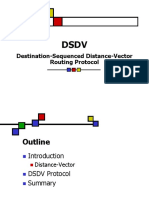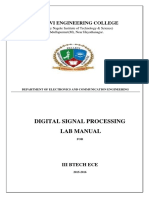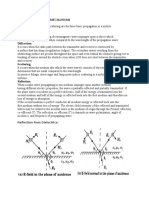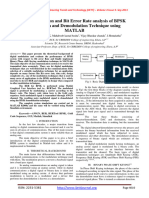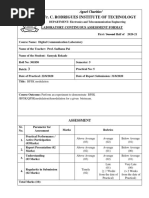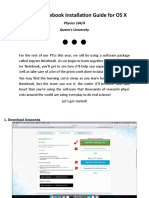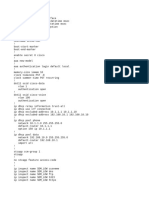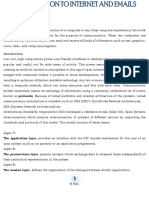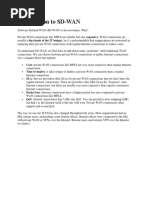Experiment No. 5: Binary Phase Shift Keying
Experiment No. 5: Binary Phase Shift Keying
Uploaded by
Govind YadavCopyright:
Available Formats
Experiment No. 5: Binary Phase Shift Keying
Experiment No. 5: Binary Phase Shift Keying
Uploaded by
Govind YadavOriginal Title
Copyright
Available Formats
Share this document
Did you find this document useful?
Is this content inappropriate?
Copyright:
Available Formats
Experiment No. 5: Binary Phase Shift Keying
Experiment No. 5: Binary Phase Shift Keying
Uploaded by
Govind YadavCopyright:
Available Formats
Department of Electronics Engineering
(NBA ACCREDIATED)
Digital Communication Laboratory
Academic Year 2019-2020
Odd Semester
Course Code ELXL 502
Subject Professor In-charge Prof. Ulka S Padwalkar
Lab Assistant Ms. Nishigandha Kharke
Student Name Rameen Tungekar
Roll Number 17103B0005
Class T.E – ETRX
Division B
Batch 1
Date of Performance 18/09/19
Date of Submission
EXPERIMENT NO. 5
Binary Phase Shift
Keying
Practical Writing
Total
Performance Presentation Sign
(10 Marks)
(5 Marks) (5 Marks)
Digital Communication Lab Manual – Sem V – ETRX
2019 - 2020
Experiment No. 5
Aim: Simulation of Binary Phase Shift Keying Modulation & Demodulation.
Estimated time to complete this experiment: 2 hours
Objective: To introduce and implement Binary Phase Shift Keying modulation technique
for digital communication.
Apparatus/Resources:
Hardware: Compatible Computer System
Software: MATLAB
Theory:
Binary Phase Shift Keying (BPSK) is a two phase modulation scheme, where the 0’s and 1’s in
a binary message are represented by two different phase states in the carrier signal: θ=0°
for binary 1 and θ=180° for binary 0.
In BPSK, the transmitted signal is a sine wave of fixed amplitude with two phases
representing two logic levels.
VBPSK (t) = 2PS cos 0t t
For logic 1 (t) = 0
VBPSK (t) . = 2PS cos 0 t
…(i)
For logic 0 (t) =
VBPSK (t) = 2PS cos 0t
= 2Pscos(
t)
…(ii)
Both signals [in equation (i) and (ii)] can be combined in one expression
as
VBPSK (t) = b (t) 2Ps cos (0t)
when 1 is transmitted : b (t) = +1
0 is transmitted : b (t) = 1.
Transmitter:
Digital Communication Lab Manual – Sem V – ETRX
2019 - 2020
Coherent Receiver:
Algorithm:
Initialization commands
BPSK Modulation
1. Generate carrier signal.
2. Start FOR loop
3. Generate binary data, message signal in polar form
4. Generate PSK modulated signal.
5. Plot message signal and PSK modulated signal.
6. End FOR loop.
7. Plot the binary data and carrier.
BFSK Demodulation
1. Start FOR loop
2. Perform correlation of PSK signal with carrier to get decision variable
3. Make decision to get demodulated binary data. If x>0, choose ‘1’ else choose ‘0’
4. Plot the demodulated binary data.
Digital Communication Lab Manual – Sem V – ETRX
2019 - 2020
Flow Charts:
Flow Chart for BPSK Modulation
Start
Enter binary Select carrier signal
sequence as input with required
frequency
Binary Data Required carrier
Converted to Polar wave is generated
Form (RZ or NRZ)
Balance
Modulator
BPSK signal is
generated
END
Flow Chart for BPSK Demodulation
START
BPSK Signal
Multiplier
Low Pass Filter
Binary Sequence
output of
Demodulator
END
Digital Communication Lab Manual – Sem V – ETRX
2019 - 2020
Program Code:
% BPSK Modulation
clc;
clear all;
close all;
%GENERATE CARRIER SIGNAL
Tb=1;
t=0:Tb/100:Tb;
fc=2;
c=sqrt(2/Tb)*sin(2*pi*fc*t);
%GENERATE MESSAGE SIGNAL
N=8;
m=rand(1,N);
t1=0;t2=Tb
for i=1:N
t=[t1:.01:t2]
if m(i)>0.5
m(i)=1;
m_s=ones(1,length(t));
else
m(i)=0;
m_s=-1*ones(1,length(t));
end
message(i,:)=m_s;
%PRODUCT OF CARRIER AND MESSAGE SIGNAL
bpsk_sig(i,:)=c.*m_s;
%PLOT THE MESSAGE AND BPSK MODULATED SIGNAL
subplot(5,1,2);axis([0 N -2 2]);plot(t,message(i,:),'r');
title('message signal(POLAR form)');xlabel('t--->');ylabel('m(t)');
grid on; hold on;
subplot(5,1,4);plot(t,bpsk_sig(i,:));
title('BPSK signal');xlabel('t--->');ylabel('s(t)');
grid on; hold on;
t1=t1+1.01; t2=t2+1.01;
end
hold off
%PLOT THE INPUT BINARY DATA AND CARRIER SIGNAL
subplot(5,1,1);stem(m);
title('binary data bits');xlabel('n--->');ylabel('b(n)');
grid on;
subplot(5,1,3);plot(t,c);
title('carrier signal');xlabel('t--->');ylabel('c(t)');
grid on;
Digital Communication Lab Manual – Sem V – ETRX
2019 - 2020
% BPSK Demodulation
t1=0;t2=Tb
for i=1:N
t=[t1:.01:t2]
%CORRELATOR
x=sum(c.*bpsk_sig(i,:));
%decision device
if x>0
demod(i)=1;
else
demod(i)=0;
end
t1=t1+1.01;
t2=t2+1.01;
end
%PLOT THE DEMODULATED DATA BITS
subplot(5,1,5);stem(demod);
title('demodulated data');xlabel('n--->');ylabel('b(n)');
grid on
Result:
Draw BPSK Modulation and Demodulation Waveform for b(t) = 1 0 1 1 0 1 on graph paper
Digital Communication Lab Manual – Sem V – ETRX
2019 - 2020
Conclusion:
Thus, we have simulated Binary Phase Shift Keying using MATLAB software.
Advantages:
1. It is most robust modulation technique due to the fact that binary 1 and 0 are
separated by 180 degree phase shift of the carrier. Due to this property, BPSK
modulated data can travel longer distances when transmitted from base station or
subscriber stations.
2. These are used for time/frequency synchronization and channel
estimation/equalization purpose.
3. BPSK modulation is used by most of the cellular towers for long distance
communication or transmission of the data.
4. BPSK demodulator requires making only two decisions in order to recover original
binary information. Hence BPSK receiver is very simple compare to other modulation
types.
5. BPSK is power efficient modulation technique as less power is needed to transmit the
carrier with less number of bits.
Disadvantages:
1. In BPSK modulation, one bit is carried by one single analog carrier. Hence data rate in bits
per second is same as the symbol rate.
2. BPSK is not bandwidth efficient modulation technique compare to other modulation types.
Real Life Application:
1. Used in various wireless standards such as CDMA, WiMAX (16d, 16e), WLAN 11a, 11b,
11g, 11n, Satellite, DVB, Cable modem etc.
2. It can withstand severe amount of channel conditions or channel fading. It is used in
OFDM and OFDMA to modulate the pilot subcarriers used for channel estimation
and equalization.
3. Different channels are used for specific data transmission in cellular systems. The
channels used to transmit system related information which are very essential are
modulated using BPSK modulation.
Post Lab Questions: (to be answered by student after experiment is completed)
1. Difference between QPSK and O-QPSK.
2. Derive and Plot PSD for BPSK Modulated Signal? Give the Bandwidth requirement and
Spectral Efficiency for same.
3. Calculate Euclidian distance for BPSK.
Digital Communication Lab Manual – Sem V – ETRX
2019 - 2020
You might also like
- Experiment 5 Line CodingDocument6 pagesExperiment 5 Line CodingMs. INDU Ms. INDUNo ratings yet
- Basics of Apache KafkaDocument168 pagesBasics of Apache Kafkav_kans100% (1)
- Adsp Lab Manual-1Document24 pagesAdsp Lab Manual-1Damai VenkatadriNo ratings yet
- 2bit Vedic Multiplier (Final)Document19 pages2bit Vedic Multiplier (Final)Joel RachamudiNo ratings yet
- Experiment-9 TE Mode Matlab PDFDocument4 pagesExperiment-9 TE Mode Matlab PDFSiddharth MakvanaNo ratings yet
- DC Lab ManualDocument49 pagesDC Lab ManualSnigdha SidduNo ratings yet
- Ee-Module 3 PDFDocument32 pagesEe-Module 3 PDFravitejNo ratings yet
- Questions Bank Final Exam Digital Communication SystemsDocument32 pagesQuestions Bank Final Exam Digital Communication SystemsYasir Yasir KovanNo ratings yet
- Sub-Band Coding of Speech Signals Using Multirate Signal ProcessingDocument6 pagesSub-Band Coding of Speech Signals Using Multirate Signal ProcessingAjinkya DeshmukhNo ratings yet
- BEC502 Lab ManualDocument49 pagesBEC502 Lab Manualrashmipriyabn527No ratings yet
- DSDVDocument31 pagesDSDVajayroy12No ratings yet
- 1.draw and Explain The Following: A) 8 QAM Receiver B) 16 QAM Transmitter and Receiver C) 16 PSK Transmitter and ReceiverDocument5 pages1.draw and Explain The Following: A) 8 QAM Receiver B) 16 QAM Transmitter and Receiver C) 16 PSK Transmitter and ReceiverDhanmathy VikashNo ratings yet
- Viva Questions For Advanced Communication LabDocument6 pagesViva Questions For Advanced Communication LabMohan Kumar K S60% (5)
- PathLOS SateliteDocument10 pagesPathLOS Sateliterakasiwi2013No ratings yet
- Cyclic Encoding & DecodingDocument3 pagesCyclic Encoding & DecodingRasool ReddyNo ratings yet
- Ec3501 Wireless Communication 1560801494 WC Lab ManualDocument24 pagesEc3501 Wireless Communication 1560801494 WC Lab Manualkarunya mittapallyNo ratings yet
- MANUAL COMMUNICATION LAB-II, KEC-651,2020-21, Even SemDocument18 pagesMANUAL COMMUNICATION LAB-II, KEC-651,2020-21, Even SemPiyushNo ratings yet
- DSP Lab Manual PallaviDocument67 pagesDSP Lab Manual Pallavib vamshi100% (1)
- Technological Innovation Management and Entrepreneurship: Model Question Paper - With Effect From 2020-21 (CBCS Scheme)Document7 pagesTechnological Innovation Management and Entrepreneurship: Model Question Paper - With Effect From 2020-21 (CBCS Scheme)Chinmaya naikNo ratings yet
- Homework Questions Convolutional CodesDocument7 pagesHomework Questions Convolutional Codesstormarmy202No ratings yet
- Simulate NRZ, RZ, Half-Sinusoid and Raised Cosine Pulses and Generate Eye Diagram For Binary Polar SignallingDocument10 pagesSimulate NRZ, RZ, Half-Sinusoid and Raised Cosine Pulses and Generate Eye Diagram For Binary Polar SignallingAbhishek nNo ratings yet
- FM 2151Document82 pagesFM 2151Nafeesa SalehNo ratings yet
- Question of Mobile Com PDFDocument4 pagesQuestion of Mobile Com PDFALI-EMAM- AL-BADINo ratings yet
- To Study The Outage Probability, LCR & ADF in SISO For Selection Combining and MRC.Document9 pagesTo Study The Outage Probability, LCR & ADF in SISO For Selection Combining and MRC.GaneshNo ratings yet
- Balanced Modulator Using DiodesDocument5 pagesBalanced Modulator Using DiodesJasdeep SinghNo ratings yet
- Experiment No.1 I DSP TMS320C6713 DSK & O DT & Matlab: Lab Manual EEE324 Digital Signal ProcessingDocument14 pagesExperiment No.1 I DSP TMS320C6713 DSK & O DT & Matlab: Lab Manual EEE324 Digital Signal ProcessingMirza Riyasat AliNo ratings yet
- Simulation Experiments-Com LabDocument14 pagesSimulation Experiments-Com LabSanjana M PNo ratings yet
- Gate 2016 Questions and AnswersDocument29 pagesGate 2016 Questions and AnswersRavi AnnepakaNo ratings yet
- Basic Propagation MechanismsDocument4 pagesBasic Propagation Mechanismsdiprodserv nigltdNo ratings yet
- Two Isotropic Point Sources of The Same Amplitude and inDocument2 pagesTwo Isotropic Point Sources of The Same Amplitude and inArun Kumar DhupamNo ratings yet
- Unit-Iii Cell Site and Mobile Antennas: Ece/Liet C410 CMC Notes Sudheer Asst Prof ECE DeptDocument10 pagesUnit-Iii Cell Site and Mobile Antennas: Ece/Liet C410 CMC Notes Sudheer Asst Prof ECE DeptJeevan Sai MaddiNo ratings yet
- DSPDocument44 pagesDSPGowri ShankarNo ratings yet
- NI-Tutorial-14516-En - Noise Analysis in MultisimDocument10 pagesNI-Tutorial-14516-En - Noise Analysis in Multisimwert1a2No ratings yet
- Experiment No.5, Simulation of DPSK Aim: To Plot The Bit Error Rate (BER) of Differential Phase Shift Keying (DPSK) Signal Using OCTAVEDocument5 pagesExperiment No.5, Simulation of DPSK Aim: To Plot The Bit Error Rate (BER) of Differential Phase Shift Keying (DPSK) Signal Using OCTAVEvanitha100% (3)
- IO Blocks and Programmable Interconnection PointsDocument29 pagesIO Blocks and Programmable Interconnection PointsNeenu IssacNo ratings yet
- Comm Lab-II (BECL504) ManualDocument45 pagesComm Lab-II (BECL504) Manualangadinandini955No ratings yet
- Unit 4 DFT and FFTDocument42 pagesUnit 4 DFT and FFThrrameshhrNo ratings yet
- DSP QBDocument7 pagesDSP QBRoopa Nayak100% (1)
- AP UNIT 4 Loop and Horn Antenna PDFDocument9 pagesAP UNIT 4 Loop and Horn Antenna PDFവി അഖിൽNo ratings yet
- Information TheoryDocument46 pagesInformation TheoryAMIE Study Circle, Roorkee100% (1)
- Decimation and Interpolation in MatlabDocument1 pageDecimation and Interpolation in MatlabmonicaeduNo ratings yet
- RC Delay Model Rise and Fall DelaysDocument24 pagesRC Delay Model Rise and Fall DelaysETHIO TECHNo ratings yet
- Subband Coding: Presented by DR.R Murugan NIT SilcharDocument11 pagesSubband Coding: Presented by DR.R Murugan NIT SilcharR MuruganNo ratings yet
- Information Theory and Coding 2marksDocument12 pagesInformation Theory and Coding 2marksPrashaant YerrapragadaNo ratings yet
- MSK ModulationDocument31 pagesMSK Modulationnassr_ismailNo ratings yet
- Reflection Coefficients For Lattice RealizationDocument8 pagesReflection Coefficients For Lattice RealizationGirija VaniNo ratings yet
- Communication Lab Course Plan Ec8561Document4 pagesCommunication Lab Course Plan Ec8561heraldNo ratings yet
- Chap 3 Path Loss Models GoodDocument50 pagesChap 3 Path Loss Models GoodMeet MehtaNo ratings yet
- Chap 7Document67 pagesChap 7palakNo ratings yet
- Emtl PPT Final PDFDocument91 pagesEmtl PPT Final PDFpravikrishna090% (1)
- QPSKDocument12 pagesQPSKATUL SACHAN100% (1)
- Discrete Fourier Series (DFS) and Discrete Fourier Transform (DFT)Document49 pagesDiscrete Fourier Series (DFS) and Discrete Fourier Transform (DFT)yadavsticky5108No ratings yet
- Advanced Communication Lab Manual PDFDocument61 pagesAdvanced Communication Lab Manual PDFRachel BartonNo ratings yet
- 2018-22 R18 ECE Co-Po MappingDocument106 pages2018-22 R18 ECE Co-Po Mapping51-Naman JainNo ratings yet
- 2marks With AnswerDocument46 pages2marks With AnswerhariNo ratings yet
- Ijett V4i9p160Document5 pagesIjett V4i9p160kuzhaloliNo ratings yet
- Implementation and Bit Error Rate Analysis of BPSK Modulation and Demodulation Technique Using MATLABDocument5 pagesImplementation and Bit Error Rate Analysis of BPSK Modulation and Demodulation Technique Using MATLABseventhsensegroup100% (1)
- Sinan SamiDocument6 pagesSinan SamiraaedNo ratings yet
- Implementation and Bit Error Rate Analysis of BPSK Modulation and Demodulation Technique Using MatlabDocument5 pagesImplementation and Bit Error Rate Analysis of BPSK Modulation and Demodulation Technique Using MatlabHayatun NufusNo ratings yet
- 15EC306J Cycle 2 ExptsDocument28 pages15EC306J Cycle 2 ExptsSanjeev KumarNo ratings yet
- Fr. C. Rodrigues Institute of Technology: Laboratory Continuous Assessment FormatDocument11 pagesFr. C. Rodrigues Institute of Technology: Laboratory Continuous Assessment FormatSudarshan PillaiNo ratings yet
- DHDFGBDocument5 pagesDHDFGBPabloDoisenbantNo ratings yet
- Safety Critical Automotive SystemsDocument23 pagesSafety Critical Automotive SystemsAriana Ribeiro LameirinhasNo ratings yet
- Ericsson IMS Call - Flows PDFDocument13 pagesEricsson IMS Call - Flows PDFJuan Ulises Capellan100% (1)
- A Deep Dive Into Transport QueuesDocument16 pagesA Deep Dive Into Transport QueuesnehrusampooriyaNo ratings yet
- 4506 28410 SpecDocument2 pages4506 28410 SpecElías Robles MoyaNo ratings yet
- GatekeeperDocument6 pagesGatekeeperSundeep RaoNo ratings yet
- Alex FaresDocument10 pagesAlex FaresSudip MokashiNo ratings yet
- NSN Lte Smart SchedulerDocument16 pagesNSN Lte Smart SchedulerSamuel TurnerNo ratings yet
- Jupyter Notebook Installation Guide (Mac)Document27 pagesJupyter Notebook Installation Guide (Mac)lhfselksfNo ratings yet
- Computer Network Tutorial by VipulDocument21 pagesComputer Network Tutorial by VipulVipul Sharma100% (1)
- Cisco UC5XX Default Conf 111Document12 pagesCisco UC5XX Default Conf 111LA-ZOUBE GAELNo ratings yet
- HUAWEI RAN KPI For Performance ManagemenDocument26 pagesHUAWEI RAN KPI For Performance ManagemenEmreNo ratings yet
- Features & Specifications: Click Here For Acrylic-Polycarbonate Compatibility Table For Suitable UsesDocument11 pagesFeatures & Specifications: Click Here For Acrylic-Polycarbonate Compatibility Table For Suitable UsesRafael PuelloNo ratings yet
- FortiOS - Net Device - Version 2020 10 28Document48 pagesFortiOS - Net Device - Version 2020 10 28mohammedjawd98No ratings yet
- ETP48200-C5A1 & C5A3 V300R002 User Manual 02Document88 pagesETP48200-C5A1 & C5A3 V300R002 User Manual 02Tarek El Deghedy100% (4)
- Modicon TM4: Expansion Modules Programming GuideDocument100 pagesModicon TM4: Expansion Modules Programming GuidemauroorsojrNo ratings yet
- Intro To Internet and EmailsDocument32 pagesIntro To Internet and Emailszakayo nyakungaNo ratings yet
- VPN - BCDocument18 pagesVPN - BCj4k4l0d4n9No ratings yet
- ATN910C Installation PDFDocument32 pagesATN910C Installation PDFJorge CamachoNo ratings yet
- 92136v00 Tips and Tricks Smart Signal Routing in SimulinkDocument2 pages92136v00 Tips and Tricks Smart Signal Routing in SimulinkJosé PerezNo ratings yet
- Airborne InternetDocument19 pagesAirborne InternetashwanthsantuNo ratings yet
- TC-NC552S: 5MP Starlight Vandalproof Mini IR Dome CameraDocument1 pageTC-NC552S: 5MP Starlight Vandalproof Mini IR Dome CameraIlham syamNo ratings yet
- UM016005E MQTT UserManual 20190730 EngDocument14 pagesUM016005E MQTT UserManual 20190730 EngSulthon MohammadNo ratings yet
- Connector User Guide: IBM TRIRIGA Application PlatformDocument70 pagesConnector User Guide: IBM TRIRIGA Application PlatformRaj pyluruNo ratings yet
- Process Platform 10.8 Installation Guide For Windows PDFDocument171 pagesProcess Platform 10.8 Installation Guide For Windows PDFchukka chukkaNo ratings yet
- How To Program Arduino With Labview Step by Step GuideDocument17 pagesHow To Program Arduino With Labview Step by Step GuideSomil N Swarna100% (1)
- B Qradar Admin GuideDocument450 pagesB Qradar Admin Guidekymi225No ratings yet
- SDWANDocument281 pagesSDWANMaharramov Turan100% (1)
- Computer Security and Penetration Testing: SniffersDocument65 pagesComputer Security and Penetration Testing: SniffersOsei SylvesterNo ratings yet










